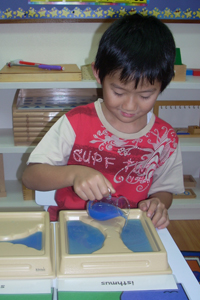The Montessori Method
"The hand is the instrument of the mind"
Maria Montessori
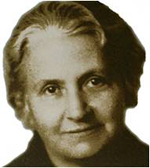 The Montessori Method was created by Dr. Maria Montessori, an Italian physician, mathematician, scientist and educator. She was born in 1870 in Chiaravalle, near Rome, Italy. Her wonderfully innovative method spread quickly all over Europe and the world for the benefit of many children. She spent her later years supervising training courses in Spain, India, England and the Netherlands. She died in 1952.
The Montessori Method was created by Dr. Maria Montessori, an Italian physician, mathematician, scientist and educator. She was born in 1870 in Chiaravalle, near Rome, Italy. Her wonderfully innovative method spread quickly all over Europe and the world for the benefit of many children. She spent her later years supervising training courses in Spain, India, England and the Netherlands. She died in 1952.
The Montessori Method is an educational philosophy. It is based on the principle that each child is an individual and should be approached on an individual basis. A properly trained Montessori teacher will guide a child's progress at the child's own pace.
Maria Montessori understood that children have "very high sensory perception". It is, therefore, very important to provide them with tangible tools to promote learning. In the Montessori classroom, great emphasis is given to creating a "Prepared Environment". Within this orderly and structured environment, the child is free to move about and make choices as part of their learning experience.
Each classroom is equipped with child-appropriate desks, chairs, and shelving arranged in a plan conducive to orderly movement and access to apparatus and learning areas. The shelves are filled with a wide variety of apparatus designed by Dr. Montessori to guide each child through the learning process. Use of the apparatus and other classroom activities develop and refine the sensorial, auditory, tactile chromatic, visual and stereognostic senses.
Some of Dr. Montessori's ideas are set forth in such books as:
Standing - Maria Montessori - Her Life and Work (1958)
Maria Montessori - The Absorbent Mind (1949)
Maria Montessori - The Montessori Method (1912)
Maria Montessori - The Secret of Childhood (1936)
Maria Montessori - Education for a Free World (1946)
Maria Montessori - To Educate the Human Potential (1948)
Montessori Curriculum
“Introducing the children to the joy of learning at an early age”
Maria Montessori
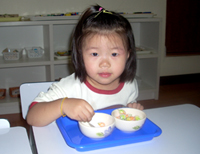 The Practical Life section lays the foundation for all other work to be done in the classroom. The activities are everyday tasks that a child needs to learn to master the care of self and care of the environment. Such activities include pouring, spooning, sorting household objects, table wiping, sweeping and tying, as well as grace and courtesy. The activities are presented to the child in such a way that concentration, coordination, independence and order are developed.
The Practical Life section lays the foundation for all other work to be done in the classroom. The activities are everyday tasks that a child needs to learn to master the care of self and care of the environment. Such activities include pouring, spooning, sorting household objects, table wiping, sweeping and tying, as well as grace and courtesy. The activities are presented to the child in such a way that concentration, coordination, independence and order are developed.
Sensorial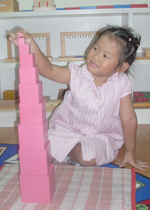
The goal of the Montessori Sensorial section is to educate the child's senses. This curriculum area contains Montessori-specific materials that help the child refine his or her experience of sight, sound, touch, taste and smell. For example, color tablets are used to develop the chromatic sense. Sound boxes refine the auditory sense. Knobbed and knobless cylinders, brown stair and the pink tower teach the children to discriminate among various sizes and shapes and indirectly prepare the child to learn mathematics and the concept of quantity. Sensory experience with materials such as these are the child's first step toward understanding the abstract concepts they represent.
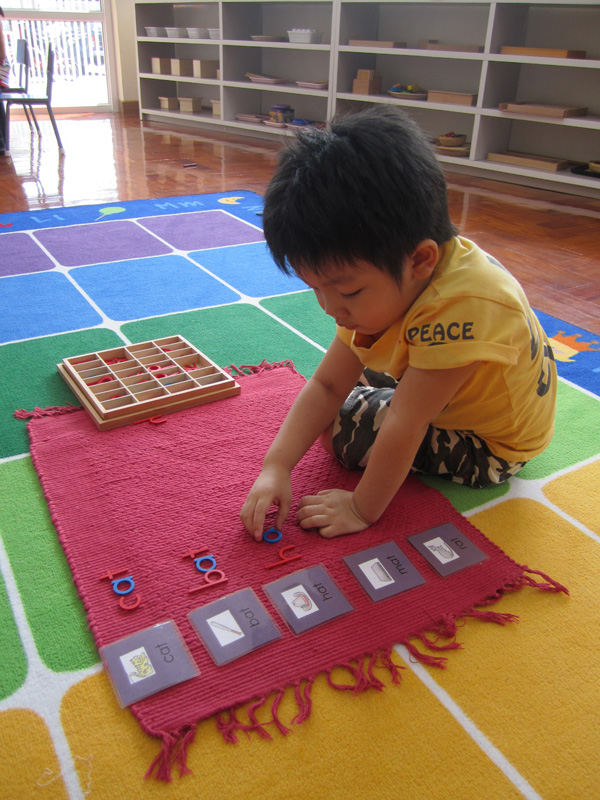 Language
Language
The Montessori classroom environment promotes reading at young age. Sandpaper letters, the moveable alphabet, beginning sounds, ending sounds, reading boxes, short vowels and long vowels all enhance the child’s language skills. Tracing, coloring, painting letters and shapes enhance these developing skills. Vocabulary increases as the child learns new words while performing various classroom activities.
Mathematics
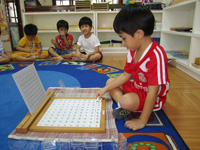 The Montessori classroom environment prepares the child to develop math skills at a young age. Sandpaper numerals and colored beads develop concepts of quantity and symbols. The spindle box teaches the child the concept of zero as a placeholder. “Golden Bead Material” introduces the child, in a wonderfully simple way, to the concept of units in tens, hundreds and thousands. Using these apparatus, and many others, addition, subtraction, multiplication, division and fractions are simple operations performed and comprehended by busy children in the Montessori classroom.
The Montessori classroom environment prepares the child to develop math skills at a young age. Sandpaper numerals and colored beads develop concepts of quantity and symbols. The spindle box teaches the child the concept of zero as a placeholder. “Golden Bead Material” introduces the child, in a wonderfully simple way, to the concept of units in tens, hundreds and thousands. Using these apparatus, and many others, addition, subtraction, multiplication, division and fractions are simple operations performed and comprehended by busy children in the Montessori classroom.
Social Studies/Science/Culture
Specially designed geography maps teach the child to recognize the world’s continents and oceans. The child is introduced to different people and cultures and the great variety of animals and insects that inhabit our planet. The child learns various parts of a flower, fish, bird, butterfly, turtle, grasshopper, and other flora and fauna.
Music, songs, poetry, nursery rhymes, and art are integral parts of the daily routine.


